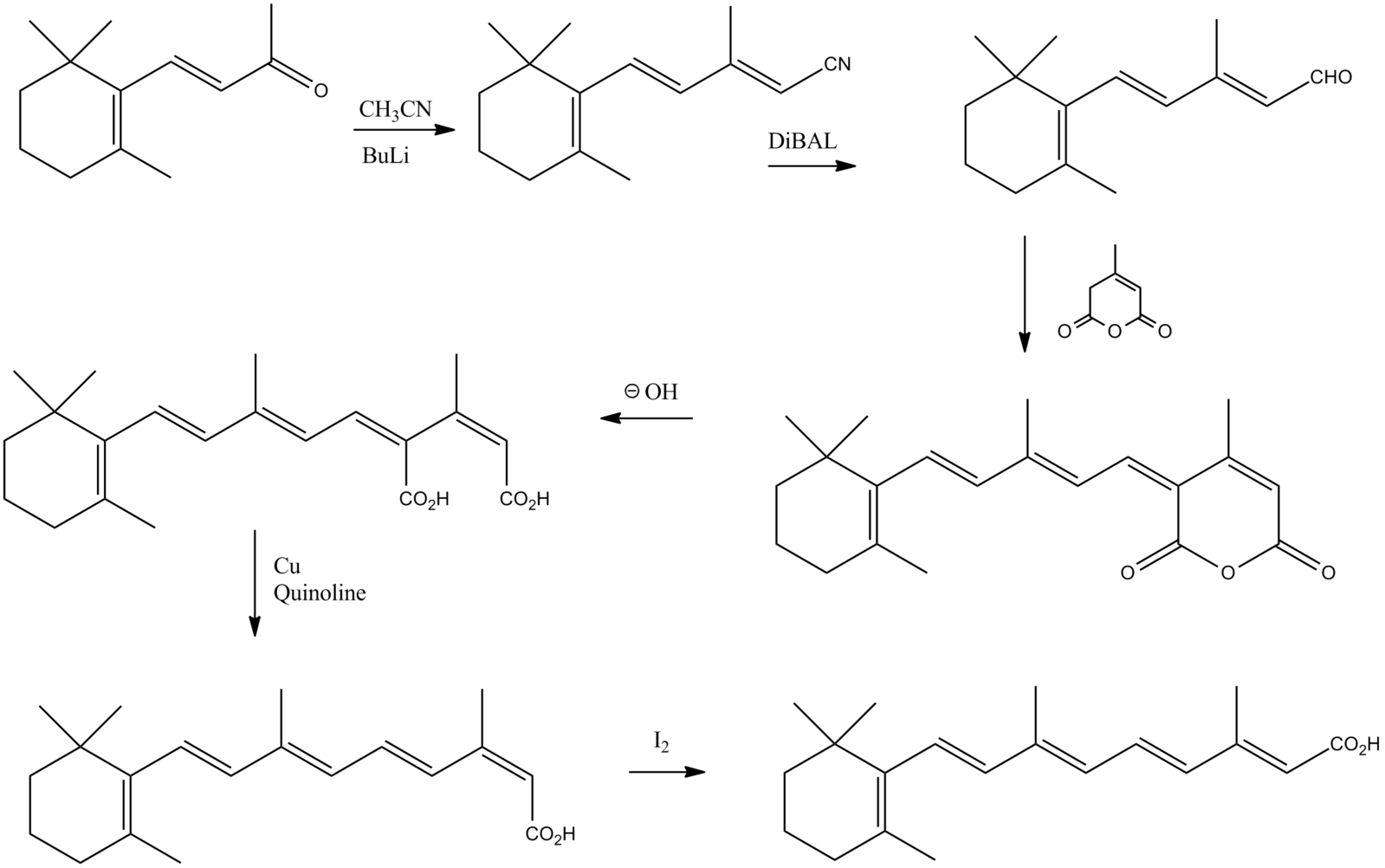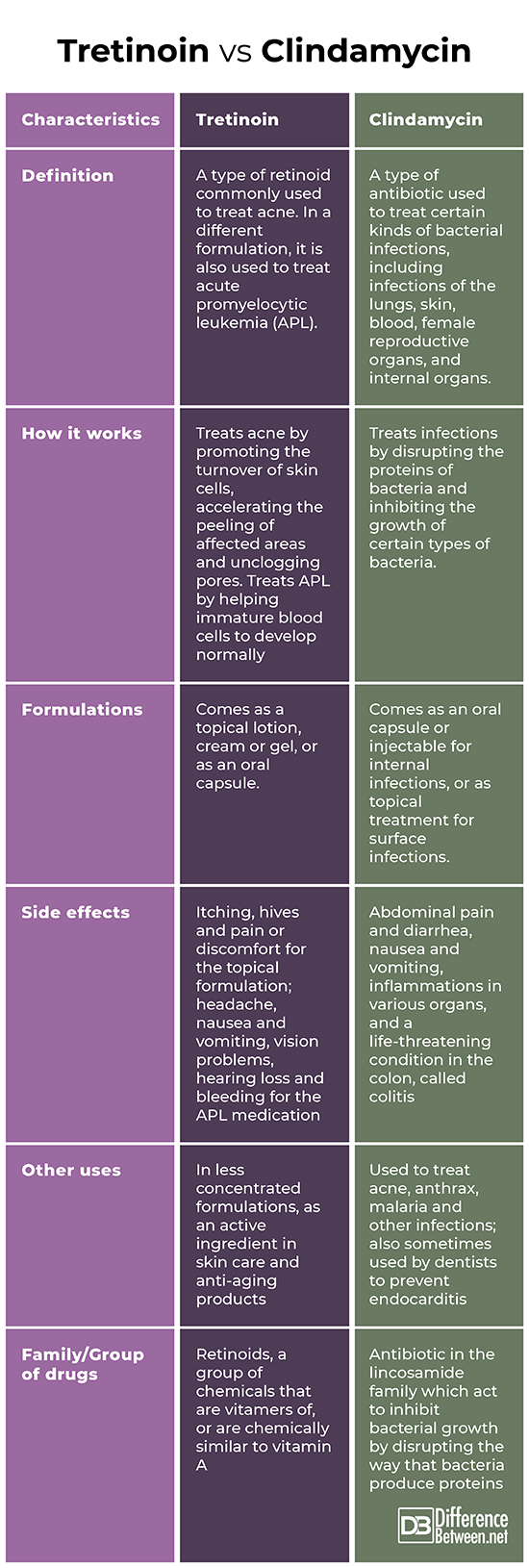Difference Between Tretinoin and Clindamycin
Tretinoin and clindamycin are two types of medication that can be found in many formulations, in different brands, and used to treat various illnesses and conditions. Even though they are common treatments, both are available only by prescription. One good reason for this limitation is that both tretinoin and clindamycin are examples of their own category of powerful chemicals with strong and potentially dangerous side effects when not used properly.
In terms of the type of chemical, tretinoin and clindamycin are vastly different. The types of illnesses and conditions they are used for are different. And even though both are used as acne medication, they function differently in how they treat this skin condition. Tretinoin is a type of retinoid, while clindamycin belongs to a family of antibacterials. All these, and more about tretinoin and clindamycin are discussed further in the following sections.

What is Tretinoin?
Tretinoin, as mentioned above, is a type of retinoid which is commonly used to treat acne. Retinoids are vitamers of, or are chemically related to, vitamin A. These chemical molecules regulate the growth of epithelial cells, cells that line the surface of many body organs such as the skin, blood vessels and internal organs. Tretinoin works to treat acne by accelerating cell turnover and promoting the peeling of affected skin areas as well as clearing clogged skin pores. Tretinoin is also used to treat acute promyelocytic leukemia (APL), a type of cancer where there is an excess of immature blood cells in the blood stream and bone marrow. Tretinoin works as a treatment by helping those immature cells to develop normally, thus decreasing or treating symptoms of the cancer although it does not prevent the cancer from returning. In the treatment for acne, tretinoin comes as a topical lotion, cream or gel and as an oral capsule to treat APL. Less concentrated formulas have also recently been developed by scientists, allowing for tretinoin to be used by pharmaceutical and cosmetics companies to use it as an active ingredient in their skin care and anti-aging products. The same action of accelerating cell growth that treats acne also serves to remove blemishes, even out the color of the skin, and reduce fine lines and wrinkles.
Careful use of tretinoin is needed, even as acne treatment. Some of the serious side effects of the topical medication are itching, hives and pain or discomfort at the treatment area. As a treatment for APL, the side effects may be even more serious, such as headache, nausea and vomiting, as well as vision problems, hearing loss, bleeding and infections. Because of its natural action of promoting cell growth, tretinoin may cause a rapid increase in the number of white blood cells in the body. There is also a high risk of it causing birth defects to a newborn, though rarely with the topical formulation. Thus, tretinoin must not be used by pregnant women or those planning to get pregnant, another reason it is available for prescription only.

What is Clindamycin?
Clindamycin is an antibiotic, now also called antibacterial, a group of medicines used to treat or prevent bacterial infections. Antibiotics work by prohibiting the growth of, or outright killing bacteria. There are many kinds of antibiotics. This is because certain types work only on certain bacteria, while certain people may have allergies from certain antibiotics. Clindamycin is an antibiotic in the lincosamide family, which works by disrupting the way that bacteria produce protein and stopping or at least slowing their reproduction. Clindamycin is mainly used to treat infections in the blood, internal organs, bones and joints, female reproductive tract, and skin. It is sometimes used to treat acne by killing or stopping the growth of bacteria in the pores. Other uses include treatment for anthrax and malaria, as well as other minor, but could potentially grow worse, infections such as ear infections, tonsillitis and pharyngitis among others. Dentists also use clindamycin to prevent endocarditis, an infection of the lining of the heart that might occur after a dental procedure in at risk people. Clindamycin typically comes as an oral capsule or injectable for internal infections, or as a topical treatment for skin and surface infections.
Like all antibiotics, clindamycin is available by prescription only, and has to be used carefully and strictly following a physician’s directions, especially about dosage, to prevent the targeted bacteria from developing immunity towards the medicine. Like many antibiotics, clindamycin has side effects such as abdominal pain and diarrhea, nausea and vomiting as well as inflammations in various organs. Clindamycin is also notoriously more likely than other antibiotics to cause an inflammation of the large intestine, a life-threatening condition called colitis, which is due to an imbalance of certain types of bacteria in the said organ.
Difference between Tretinoin and Clindamycin
Definition
Tretinoin is a type of retinoid commonly used to treat acne and to treat acute promyelocytic leukemia (APL). Clindamycin is an antibiotic used to treat or prevent many types of bacterial infections.
How it works
Tretinoin treats acne by promoting the turnover of skin cells, accelerating the peeling of affected areas and unclogging pores. It works to treat APL by helping immature blood cells to develop normally. Clindamycin works to treat infections by disrupting the proteins of bacteria and inhibiting the growth of certain types of bacteria.
Formulations
Tretinoin usually comes as a topical lotion, cream or gel for acne treatment or as an oral capsule for treating APL. Clindamycin usually comes in a capsule to be ingested, as an injectable for other internal infections, or as topical treatment for skin and surface infections.
Side effects
Side effects for tretinoin include itching, hives and pain or discomfort for the topical formulation, as well as headache, nausea and vomiting, vision problems, hearing loss and bleeding for the APL medication. Clindamycin may cause abdominal pain and diarrhea, nausea and vomiting, inflammations in various organs, and a life-threatening condition in the colon, called colitis.
Other uses
Tretinoin is now also being used, in less concentrated formulations, as an active ingredient in skin care and anti-aging products. Clindamycin is also used to treat acne, anthrax, malaria and other infections. It is also sometimes used by dentists to prevent endocarditis.
Family/Group of drugs
Tretinoin is a retinoid, a group of chemicals that are vitamers of, or are chemically similar to vitamin A. Clindamycin is an antibiotic in the lincosamide family which act to inhibit bacterial growth by disrupting the way that bacteria produce proteins.
Tretinoin vs Clindamycin

Summary
- Tretinoin and clindamycin are two types of medications that are very different. Tretinoin is a type of retinoid, chemicals that resemble vitamin A, and used in medicine to regulate the growth of cells that line the surface of many organs such as the skin, heart and lungs. Clindamycin is a type of antibiotic, medicines that inhibit the growth of bacteria.
- Tretinoin is used mostly to treat acne. Clindamycin is only sometimes used to treat acne. Tretinoin treats acne by promoting growth of skin cells, accelerating cell turnover and thus clears the affected area and unclogging pores. Clindamycin treats acne by killing or inhibiting the growth of bacteria living in the pores that usually make acne worse.
- Both tretinoin and clindamycin are prescription drugs, owing to their dangerous side effects when used improperly. However, in the case of tretinoin, less concentrated formulations have found its way as an active ingredient in skin care and anti-aging products, working in a similar fashion as acne treatment, accelerating cell turnover which results in younger looking skin.
- Difference Between Hematoma and Melanoma - February 9, 2023
- Difference Between Bruising and Necrosis - February 8, 2023
- Difference Between Brain Hematoma and Brain Hemorrhage - February 8, 2023
Search DifferenceBetween.net :
Leave a Response
References :
[0]Caporuscio, Jessica. "What to know about clindamycin." MedicalNewsToday. May 29, 2019. https://www.medicalnewstoday.com/articles/325326.php (accessed January 13, 2020).
[1]Ogletree, Kelsey. "Everything You Need to Know About Tretinoin—The Anti-Aging Ingredient Derms Swear By." Real Simple. March 27, 2019. https://www.realsimple.com/beauty-fashion/skincare/tretinoin-topical-cream (accessed January 13, 2020).
[2]The American Society of Health-System Pharmacists. "Clindamycin ." MedlinePlus. May 15, 2018. https://medlineplus.gov/druginfo/meds/a682399.html (accessed January 13, 2020).
[3]The American Society of Health-System Pharmacists. "Tretinoin." MedlinePlus. September 15, 2016. https://medlineplus.gov/druginfo/meds/a608032.html (accessed January 13, 2020).
[4]The American Society of Health-System Pharmacists. "Tretinoin Topical." MedlinePlus. March 15, 2019. https://medlineplus.gov/druginfo/meds/a682437.html (accessed January 13, 2020).
[5]Image credit: https://en.m.wikipedia.org/wiki/File:Clindamycin_phosphate.png
[6]Image credit: https://commons.wikimedia.org/wiki/File:Tretinoin.png
